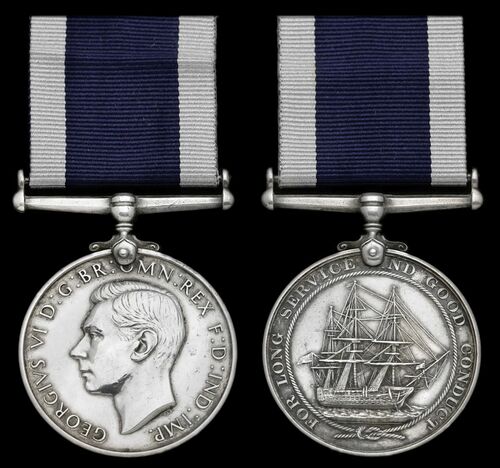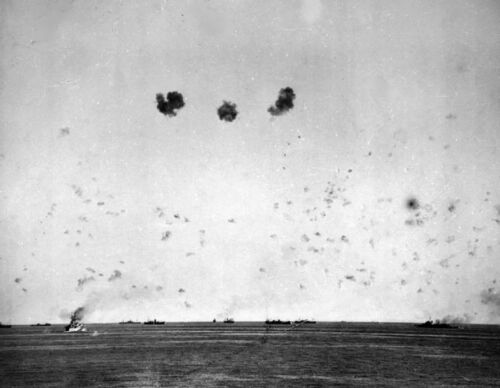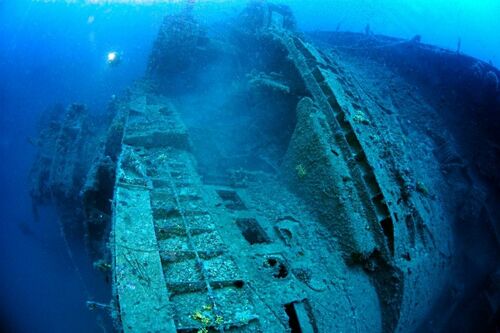Auction: 23001 - Orders, Decorations and Medals
Lot: 432
The Royal Navy L.S. & G.C. Medal awarded to Sergeant E. J. Jarvis, Royal Marines, who survived the loss of the cruiser H.M.S. Manchester during Operation "Pedestal"
Manchester's captain's decision to scuttle his heavily damaged ship became the subject of a contentious Court Martial but he must have taken comfort from the words of one of his ratings: 'The Captain decided that his choices were to wait until dawn and get blown to buggery, or to save the men'
Jarvis later served in the aircraft carrier Formidable in the Pacific and was consequently present when she was hit by two kamikaze aircraft off Okinawa in May 1945, telling strikes that resulted in casualties of nine killed and 59 wounded
Royal Navy L.S. & G.C., G.VI.R., 1st issue (PO. 21829 E. J. Jarvis, Sgt., R.M.), good very fine
Ernest John Jarvis was born in Sliema, Malta on 26 January 1906, the son of a Royal Artilleryman, and joined the Portsmouth Division of the Royal Marines in September 1923.
Advanced to Sergeant in April 1936 and awarded his L.S. & G.C. Medal in January 1939, he was serving in the battleship H.M.S. Ramillies on the outbreak of hostilities. Having then come ashore in November 1941, he returned to sea in the cruiser Manchester in April 1942. He consequently shared in her part on the Arctic run, including participation in the disastrous PQ-17 operation, and was present at her loss on the Malta run in August 1942.
Operation "Pedestal"
In August 1942, Manchester was ordered to the Mediterranean and took part in Operation "Pedestal".
The importance of "Pedestal" needs little introduction here, Winston Churchill himself requesting regular updates as to the convoy's progress, but for the record's sake it is worth registering the bare facts: of the 14 merchantmen that set out, nine were sunk and three damaged, while the Senior Service's input of 59 escorts - the largest such force ever assembled in defence of a convoy - sustained losses of an aircraft carrier, a cruiser and a destroyer, as well as having another half a dozen ships damaged. That cruiser was Manchester.
In the early hours of 13 August, some four miles off Kellibia, Tunisia, Manchester was torpedoed and severely damaged. Struck amidships on the starboard side by two torpedoes fired by the Italian torpedo boats MAS 16 and MAS 22, she sustained flooding in the engine room, after boiler room and the 4-inch magazine. Completely disabled and with no power, she developed a 10-12-degree list.
About 160 members of the ship's company were taken off by the destroyer Pathfinder, whilst others were subsequently rescued from rafts by Eskimo and Somali. However, efforts to control the flooding and enable the ship to return to Gibraltar proved unsuccessful and scuttling charges were placed. After the remainder of the ship's company had abandoned ship the charges were detonated; a torpedo from Pathfinder is reported to have assisted in the sinking.
Manchester sank at 0400 hours local time on the 13 August 1942.
Jarvis was fortunate to be among those picked up by one of our destroyers, thereby avoiding an unpleasant sojourn as a guest of the Vichy French.
Court Martial
After lengthy statements had been submitted from all witnesses and Admiralty experts, Manchester's commanding officer, Captain Harold Drew, was court-martialled on a charge of negligence. He claimed that he was unaware that Manchester retained mobility, after the torpedo hit, and that he understood that her armament was also largely incapacitated. The court proceedings determined that Manchester's damage was remarkably similar to that suffered on 23 July 1941; that Manchester was capable of steaming at 10-12 knots on her port outer propeller shaft, that her main and secondary armament was largely intact, and that the initial list of 10-11 degrees had been considerably reduced via counter-flooding and transfers of fuel oil.
Drew was found guilty, reprimanded and prohibited from further command at sea. It remains a contentious decision for Manchester had been crippled and Drew feared the ship, including her secret radar gear, might fall into enemy hands. The surviving crew members strongly supported both Captain Drew's assessment of the ship's situation and his decision to scuttle her, with one rating stating:
'The Captain decided that his choices were to wait until dawn and get blown to buggery, or to save the men.'
Subsequent career - kamikaze attacks
Jarvis was very much back in the thick of the action in the period June 1944 to June 1945, when he was employed in the aircraft carrier Formidable.
Having participated in Operation "Goodwood", the Fleet Air Arm strike on the Tirpitz in August 1944, Formidable sailed for the Pacific and it was here, in the Okinawa operations of May 1945, that she was twice struck by kamikaze aircraft. On the first occasion - on the 4th - she sustained serious damage and the casualties of eight killed and 55 wounded. On the second occasion - on the 9th - another crew member was killed and four wounded, and 18 of her Corsairs were destroyed.
Jarvis departed the aircraft carrier in the following month and was released 'Class A' in October 1945. He subsequently found employment as a transport driver on the naval establishment and died in Portsmouth in December 1973.
Subject to 20% VAT on Buyer’s Premium. For more information please view Terms and Conditions for Buyers.
Sold for
£260
Starting price
£70









